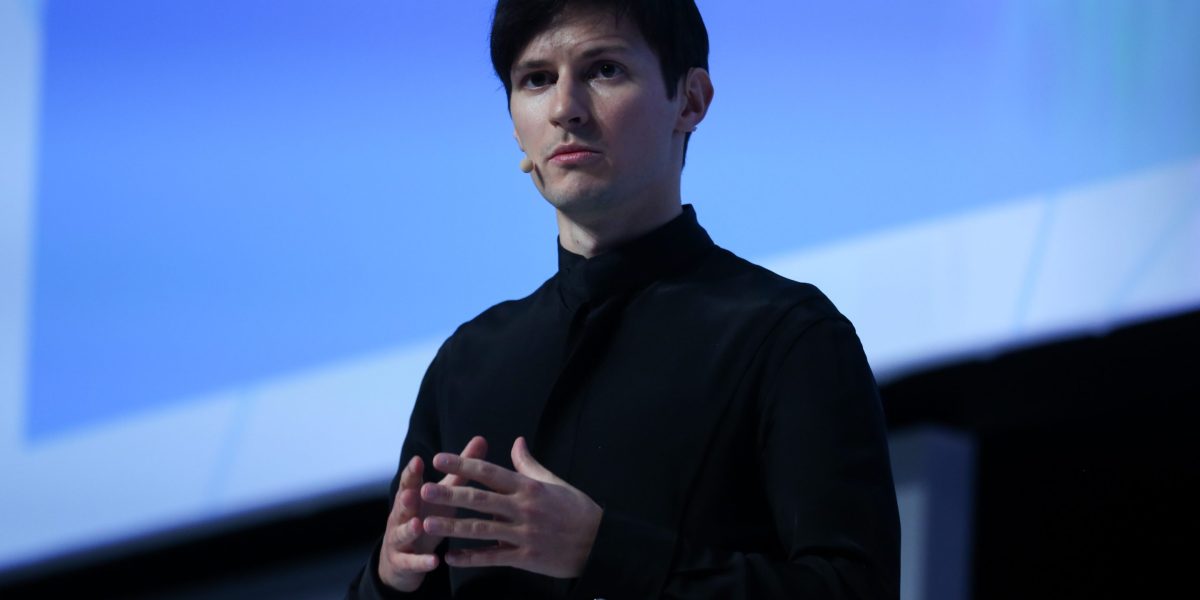

Pavel Durov, the founder and CEO of the social networking platform Telegram, had just arrived in his private jet at a small airport outside of Paris, France, on Saturday when he was arrested by French officials and taken into custody. Durov’s detention reverberated across the world and led X owner Elon Musk and others to demand a response from French President Emmanuel Macron, who insisted the investigation was not political.
Details surrounding Durov’s detainment are still emerging and, in the meantime, investors who have financed the company and salivated over a potential IPO are watching closely. Many are likely anxious over the degree to which Durov’s fate will determine the future of Telegram, a platform that boasts nearly a billion users but is also tied to a $14 billion cryptocurrency, called TON.
Telegram may appear similar to other messaging platforms like WhatsApp at first glance, but it’s different in key respects. That includes its embrace of blockchain technology, including its close integration with the cryptocurrency TON through games, payments, and an advertiser network on its platform.
With Durov’s future up in the air, some investors are trying to distance the two entities.
“We wouldn’t call this at all an ‘existential’ crisis for Telegram,” the TON backer Kingsway Capital wrote in an investor letter Tuesday morning, according to a copy reviewed by Fortune.
But while Durov has recently boasted of Telegram’s near profitability, and even touted plans to take the company public, some investors and experts who spoke with Fortune characterized the company as a “dictatorship” whose direction, and prospects, were tied to Durov—and its volatile crypto gambit.
A spokesperson for Telegram did not immediately respond to a request for comment.
Telegram has long been a platform rife with contradictions. The Russian-born Durov had previously founded VKontakte, his home country’s largest social network, but balked at the government’s strict demands. Though he still faces accusations of working with the Kremlin—which Telegram representatives have firmly denied—Durov founded Telegram outside of Russia to be a “neutral platform” and left his native country.
Meanwhile, Telegram’s lax approach to moderation has made it a popular forum for everyone from those looking for unfiltered news on the war in Ukraine to U.S. right-wing ideologues. The platform is also awash with drug dealers and fraud chatrooms. Its userbase has now surpassed 900 million, Durov said in March.
While purportedly a privacy-focused app, Telegram still faces criticism from security experts for its lack of default end-to-end encryption. “We don’t have confidence in it being secure,” said Natalia Krapiva, a senior tech counsel for the digital rights nonprofit Access Now in an interview with Fortune.
Despite its massive growth, Telegram has long struggled to monetize the platform. According to Elies Campo, a former employee focused on growth and business development at Telegram from 2015 through 2021, Durov avoided raising money by offering equity in his company to investors because of the bad taste left in his mouth from VKontakte. “It’s evolved organically based on these experiences and the need for control,” Campo told Fortune, adding that employees were not even granted equity.
Those experiences include Telegram’s 2018 attempt to capitalize on the red-hot trend of initial coin offerings, or ICOs—the crypto world’s spin on initial public offerings that saw buyers receive digital tokens instead of shares.
Telegram’s ICO succeeded spectacularly, leading the platform to raise $1.7 billion from investors after it announced a pivot into crypto—a field that dovetailed with Durov’s professed ideals of free speech and privacy.
But the U.S. Securities and Exchange Commission had other ideas. The agency sued Telegram in 2019, alleging that the ICO constituted an unregistered securities offering, and ordered the company to halt its planned launch of a token and return more than $1.2 billion to investors.
The episode would come to shape Telegram’s financial future, throwing Telegram into even further turmoil after it was forced to return the funds it hadn’t yet spent. According to the Wall Street Journal, Durov offered non-U.S. investors the ability to convert their refunds into one-year loans. But one U.S. investor, who spoke with Fortune on the condition of anonymity, said they only received a partial refund.
In the wake of the aborted token launch, Telegram owed creditors a reported $700 million, with Durov announcing on his own platform that the company needed “at least a few hundred million dollars per year to keep going.” Still, it didn’t offer equity, instead raising funds through debt financing in the form of bonds, which included a sweetener of a 10% discount to the listing price, if Telegram ever went public. Telegram raised $1 billion through a bond offering, including $150 million from Mubadala and Abu Dhabi Catalyst Partners—and, in an interesting twist given events at Durov’s last social network, Russia’s state investment fund— in early 2021. Telegram later raised capital in subsequent financing rounds of $210 million in 2023 and $330 million in 2024.
Prior to TON, investors never had a path to make a venture-like investment in the company. But that would change.
After Telegram abandoned its crypto plans, a group with deep roots in Telegram and VKontakte, including former VK CEO Andrew Rogozov, continued to work on a blockchain, eventually launching a new organization called the TON Foundation that, at least in legal structure, was independent of the social media network.
The community developers worked to launch the blockchain with ostensible separation from Telegram, which transferred the rights to the crypto project’s website and GitHub account in 2021.
With the crypto world awash in also-ran blockchains that sought to challenge Bitcoin and Ethereum, investors told Fortune that TON was different because of its connections with Telegram. Even if Ethereum and Solana (another popular blockchain) have better tech, they don’t have mainstream users. Telegram integrating TON, however, could mean the long-awaited killer app for crypto and kickstart adoption of the blockchain’s broader ecosystem. “TON is exciting for mostly reasons of distribution,” said Alex Felix, the chief investment officer at CoinFund, which invests in the token. “That was the big difference in what they were bringing to market.”
In this sense, Telegram was poised to achieve what Meta’s Mark Zuckerberg had sought to do in 2018 with an ill-fated project known as Libra, which promised to introduce a native cryptocurrency for users around the world. That project ground to a halt under withering scrutiny from the U.S. Congress and other lawmakers.
After launching the public version of its blockchain in May 2021, TON would face accusations of centralization—a taboo in crypto—especially given rules around governance and token distribution that some investors and analysts described as opaque. The crypto research firm White Rabbit found that 85.8% of the initial token supply was mined by a few groups of miners connected with each other and affiliated with the TON Foundation. Campo told Fortune that the relationship between Telegram and TON is still unclear, including how much of the token Telegram owns.
Durov would later announce his plans to limit Telegram’s share of TON to around 10% of the supply, selling surplus holdings to long-term investors under lockups, to support a “decentralized ecosystem.”
One crypto VC, who spoke with Fortune on the condition of anonymity to discuss their investment plans, said they decided to pass on TON because of concerns around transparency and regulation. “It’s not easily accessible, and you can’t verify all the information,” they said.
That didn’t stop other investors. TON didn’t serve as a direct proxy for investing in Telegram, but it was the next best thing. And especially as Telegram began to integrate crypto into its platform, TON became an attractive gamble for investors hoping to find a blockchain application that was used by real people. After Telegram announced an ad network with TON payments earlier this year, the market cap exploded to over $25 billion, further buoyed by the success of TON-powered minigames offered on Telegram like the wildly popular Hamster Kombat.
“You can think of Telegram as a massive bootstrap for the TON ecosystem,” said Yat Siu, the chairman of the crypto giant Animoca Brands, which also runs the largest validator on TON.
TON also represented something valuable to Telegram. Its success meant that the renegade platform could implement payments without the need to rely on fiat currencies—and more importantly, it could potentially strike gold on a revenue stream that would preclude the need to bring in outside investors. “I think it would be very difficult for Telegram to be a public company and have TON fulfill [Durov’s] vision,” said Felix. “I don’t know that they’re mutually exclusive, but it’s probably pick one or the other.”
Matthew Graham, the founder and CEO of the VC firm Ryze Labs, said that one of the reasons he invested in TON was because of the difficulty Telegram would likely face trying to go public. “We talked about that a lot internally,” he told Fortune. “How realistic is it that they would actually IPO, and to what extent might they be thinking about [TON] as the path to monetize.”
When a CEO builds a company around themselves and maintains tight control, there are distinct risks. According to Campo, the former employee, Telegram only has around 60 core employees—a staggeringly low number for a social media platform boasting nearly one billion users. “Everything goes through this guy,” said Graham. “It’s a dictatorship.”
The dust is still settling from Durov’s arrest, and it’s not even clear yet which charges—if any—he will actually face. There was one proxy for evaluating the impact of his detention on Telegram: The price of TON dropped as much as 25% on Sunday, losing $3 billion.
Investors are still grappling with the fallout. “The history of blockchains such as Bitcoin, Ethereum or TON has long been accompanied by bans and threats of bans, which hasn’t stopped the industry,” Kingsway Capital wrote in the investor letter. “TON could even operate entirely independent of Telegram.”
Still, while the future promise of TON would be an ecosystem that thrives outside of Telegram, it is still—at least for now—dependent on Telegram. Depending on the charges, Durov could be forced to implement more moderation and know-your-customer provisions within Telegram—an expensive proposition that could spell the end of its crypto experiment.
Campo said that during his time at Telegram, Durov never implemented a succession plan. “Nobody really knows how to solve [moderation] at scale,” he said. “Telegram will have to change and go beyond this 60-person group of hackers.”















